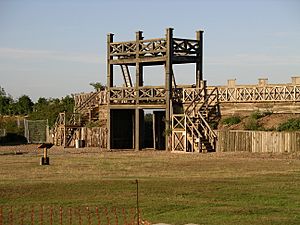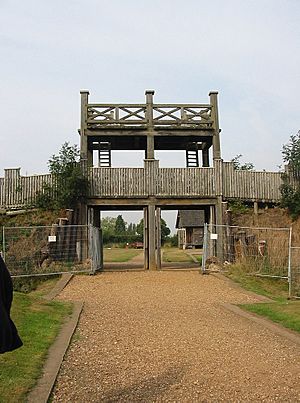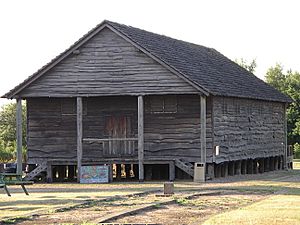Lunt Roman Fort facts for kids
Quick facts for kids Lunt Roman Fort |
|
|---|---|
| Baginton, Warwickshire | |

The reconstructed main gatehouse as seen from inside the fort.
|
|
| Site information | |
| Open to the public |
Yes |
| Condition | Partially reconstructed |
The Lunt Roman Fort is an old Roman fort in Roman Britain. We don't know its original name. It is located in the village of Baginton, near Coventry. Today, you can visit the fort.
Archaeologists have dug up the entire site. They have also rebuilt parts of it. For example, the main wooden gate was rebuilt. Experts used the same tools and methods that Roman soldiers would have used. In 2001, some Anglo Saxon items were found there too. These items are from a time after the Romans left Britain.
Contents
Where is the Fort Located?
The Lunt Fort is built on a high spot. Just north of the fort, there is a steep bank. This bank goes down to the River Sowe. From the top of the bank, you can see for about 2.5 miles (4 km) to the north. This high view was good for watching out for enemies.
A Look at the Fort's History
Archaeologists have found that the fort was used four different times. These times were usually during periods of trouble in Roman Britain.
The fort was first built around 60 AD. It was used as a place to store supplies. It also served as a main base for a Roman army group. This was during the final battles against Boudica, a famous British queen.
From 64 AD, a smaller Roman army group called a cohort used the fort. They made the fort smaller. But archaeologists have found many important buildings from this time. These include the principia (headquarters building) and the praetorium (commander's house). They also found two granaries (food stores) and six barrack blocks (where soldiers slept).
Some buildings were taken down to build a special round area called a gyrus. Many horse items were found, suggesting horses were kept there. There was also a large area for working with metal. This shows that a cavalry (horse-riding) unit might have been at the fort then. This second period of use lasted until 77 or 78 AD.
The third period was from 77 or 78 AD to 79 AD. During this time, two ditches were dug around the fort. A gate with two entrances was built on the south side. People also lived outside the fort's walls. After this, the fort was no longer used for a long time.
Around 260 AD, the fort might have been used again for a short time. This was possibly during a time when a rebel empire ruled parts of the Roman Empire. This idea comes from a single coin found at the fort. The coin was from the time of Emperor Gallienus (260–268 AD). However, the coin might have just been dropped there much later.
The Mysterious Gyrus
Most Roman forts were shaped like a playing card, with straight sides. But the Lunt Fort is different. Its eastern side bulges out in a circle. This circle is called a gyrus. It is about 32 meters (105 feet) across. The ground inside was dug out about 60 to 90 centimeters (2 to 3 feet) deep. A wooden fence surrounded the area.
This gyrus is the only one known in the entire Roman Empire. Experts believe it was used for training horses. Horses might have been trained by making them walk in circles on a long rope. This method is called "lungeing." The United States Cavalry used similar circular areas for horse training much later.
The gyrus was added to the fort during its second period of use. Building it changed the fort's shape. The wall had to curve to fit the gyrus. This made the fort's layout very different from other Roman forts. This unique feature makes the Lunt Fort special in Britain and the Roman Empire.
Discovering the Past: Archaeology
People first found Roman pottery at the site in the 1930s. This showed that a Roman fort was there. In the 1960s, Brian Hobley, an archaeologist, started a long project. He wanted to dig up the fort and study how Romans built their camps. His team found evidence of the fort being used three different times.
In the 1970s, some parts of the fort were rebuilt. These reconstructions were placed on the original foundations. They rebuilt a section of the wall and a gateway. This gate was designed like those seen on Trajan's column, a famous Roman monument. They also rebuilt one of the three granaries and the gyrus.
In 2001, students found a piece of Roman pottery called Samian ware. They also found a coin with Nero's head on it, from 65 AD. Other discoveries include a ring with a palm leaf design. This design was a symbol of victory. It was often worn by successful gladiators.
In 2001, evidence of Saxon settlements was also found. Later, items from the Middle Ages were discovered. These included large post holes and a ditch filled with pottery.
Today, the Lunt Fort is open to the public. Schools can visit, and guided tours are available. Many people have also joined holiday digs to help with excavations.




